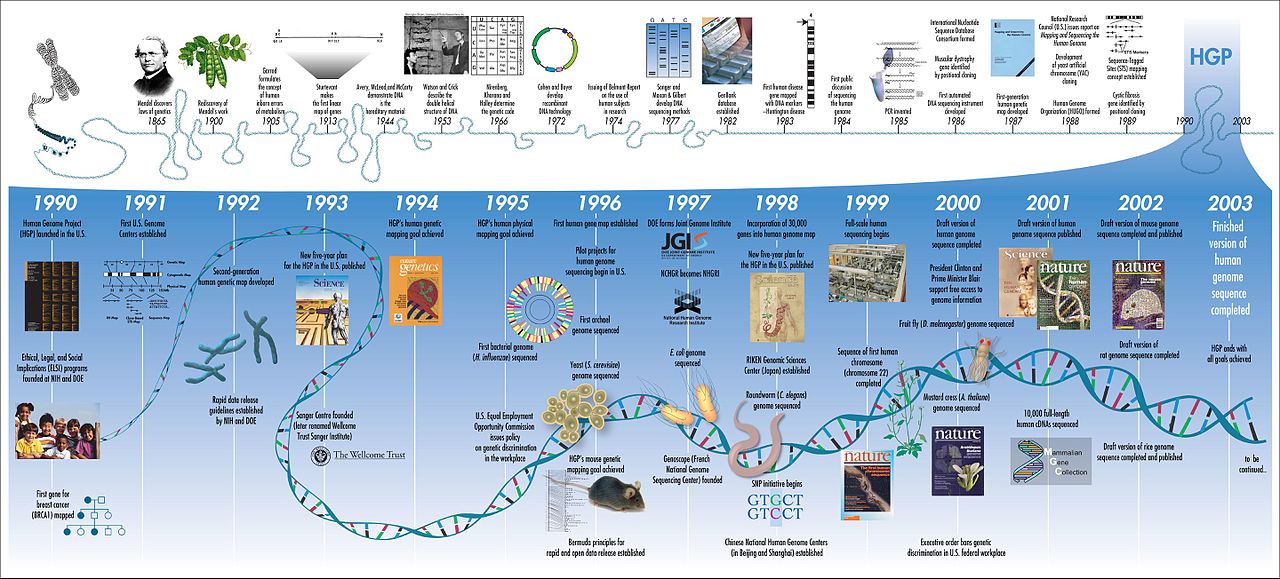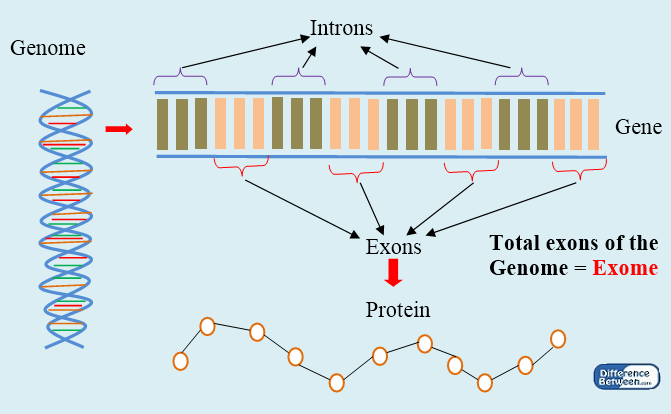Difference Between Genome and Exome
Key Difference – Genome vs Exome
The Human Genome Project, which commenced in 1911, was a revolution in the history of modern genetics that gave rise to many analytical techniques in terms of genetic diagnosis and gene therapy. The Human Genome Project was a US based collaborative research program whose goal was the complete mapping and understanding of all the genes of human beings. Based on this research project, the terms Genome, Intron and Exon were developed. Genome is the complete set of genes in an organism which accounts for all the genes present in that particular organism, whereas Exome is the complete set of exons present in an organism which accounts for all the coding regions of genes present in a particular species. This is the key difference between genome and exome.
CONTENTS
1. Overview and Key Difference
2. What is Genome
3. What is Exome
4. Similarities Between Genome and Exome
5. Side by Side Comparison – Genome vs Exome in Tabular Form
6. Summary
What is Genome?
Genome refers to the complete set of genetic instructions which is stored as genes or specific sequences of Deoxyribonucleic acids (DNA) in a particular organism or species. Each genome contains all the information required for growth, development and other functional activities of a particular organism. The genome is made up of DNA which is in the nucleus of eukaryotes and in the cytoplasm of prokaryotes.
Genetic codes in the human genome are made up of 3.2 billion bases DNA which is composed of four types of nucleotides: Adenine, Guanine, Cytosine, and Thymine. Different sequential orders of these four bases define the uniqueness of a particular gene. The eukaryotic genome includes both nuclear DNA and mitochondrial DNA. Thus, this unique combination differs from organism to organism, and an individual’s genome is unique in nature and can act as a fingerprint for diagnostic purposes.

Figure 01: The Human Genome project
The first Genome that was sequenced and identified was that of Escherichia coli; later, yeasts, protozoans, and plant genomes were analyzed. The sequencing of the human genome took a couple of decades for its completion. The human genome contains approximately 3 200 000 000 nucleotides, about 30,000 to 40,000 genes which are coding and non-coding genes, and is compactly packed into 23 pairs of chromosomes which carry the packaged DNA which acts as the genetic determinants. This gene packaging is a result of the tightly twisted DNA helical structures and the protein associated complex formation which reduces the length which is occupied by DNA in its noncompacted phase.
What is Exome?
Exome is a subset of the genome which only consists of the coding regions of the genes of a particular organism. Coding regions of the genes are named as exons, and they are a type of genes which are transcribed into mRNA and then translated into amino acid sequences, giving rise to functional and structural proteins. During post transcriptional modifications in eukaryotes, the introns which are non-coding regions are removed, and the exons are joined. This is done by a process known as RNA splicing. In prokaryotes there are no or fewer introns; hence, RNA splicing is not required. Thus, in order to generate the exome of a particular organism, mature RNA should be extracted, and then the complementary DNA should be synthesized using reverse transcriptase enzyme.

Figure 02: Exome
The exons of all our genes makeup approximately 1.5% of the genome and contain only about 3 megabases since the exome accounts for a small percentage of the entire genome. It is cheaper and faster to sequence the exome than the entire genome. Exome analysis provides important information on functional properties of an organism, and mutations observed in the exome are directly related to a clinical manifestation.
What are the Similarities Between Genome and Exome?
- Genome and exome are composed of a set of genes in an organism.
- Both contain four main nucleotide bases; Adenine, Guanine, Cytosine, and Thymine.
- Genome and exome are condensed into chromosomes and is arranged in a highly compact fashion.
- Sequencing of both Genome and the exome can be performed under in vitro.
- Genome and exome are helpful in analyzing genetic mutations that could be the reason for genetic diseases and other noncommunicable diseases and metabolic imbalances.
What is the Difference Between Genome and Exome?
Genome vs Exome | |
| The complete set of genetic instructions which is stored as genes or sequences of DNA in a particular organism or species is known as the genome. | A subset of the genome which only consists of the coding genes of a particular organism is known as the exome. |
| Size | |
| The genome is large, about 3 200 000 000 nucleotides. | The exome is small, about 3 000 000 nucleotides (1% of the genome). |
| Composition | |
| Genome is composed of total DNA content including both coding and non-coding regions. | Exome contains only coding regions of the total DNA known as exons. |
| Sequencing | |
| Simple methods such as Sanger sequencing can be used in sequencing the genome. | Complex methods which include reverse transcription of mature mRNA are required to sequence exome. |
Summary – Genome vs Exome
Genome is the complete set of DNA present in an organism. Exome is a part of the genome which includes only the exons of the entire set of genes. This is the basic difference between genome and exome. Both genome and exome analysis is an upcoming field of science and is much utilized in recombinant DNA technologies to analyze the genes present in an organism and develop methods to manipulate the genes in order to be used beneficially.
Download PDF Version of Genome vs Exome
You can download PDF version of this article and use it for offline purposes as per citation note. Please download PDF version here Difference Between Genome and Exome
References:
1. “An Overview of the Human Genome Project.” National Human Genome Research Institute (NHGRI), Available here. Accessed 30 Aug. 2017.
2. Brown, Terence A. “The Human Genome.” Genomes. 2nd edition., U.S. National Library of Medicine, 1 Jan. 1970, Available here. Accessed 30 Aug. 2017.
3. “Crowdsourcing Cures on your terms.” Genos, Available here. Accessed 30 Aug. 2017.
Image Courtesy:
1. “Human Genome Project Timeline (26964377742)” By National Human Genome Research Institute (NHGRI) from Bethesda, MD, USA – Human Genome Project Timeline (CC BY 2.0) via Commons Wikimedia
ncG1vNJzZmivp6x7pbXFn5yrnZ6YsqOx07CcnqZemLyue8OinZ%2Bdopq7pLGMm5ytr5Wau26zxKempp1dlruledWsZJ6wn6KycA%3D%3D